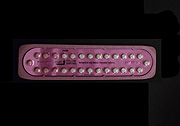- Navigating Your Midlife Crisis: Embracing New Possibilities
- City Raccoons Showing Signs of Domestication
- Mapping the Exposome: Science Broadens Focus to Environmental Disease Triggers
- One Week Less on Social Media Linked to Better Mental Health
- Your Brain Changes in Stages as You Age, Study Finds
- Some Suicide Victims Show No Typical Warning Signs, Study Finds
- ByHeart Formula Faces Lawsuits After Babies Sickened With Botulism
- Switch to Vegan Diet Could Cut Your Greenhouse Gas Emissions in Half
- Regular Bedtime Does Wonders for Blood Pressure
- Dining Alone Could Mean Worse Nutrition for Seniors
Women Spend Far Less on Birth Control Because of ‘Obamacare’


Out-of-pocket costs for prescription birth control have dropped significantly since the Affordable Care Act, commonly known as “Obamacare,” took effect in the United States, a new study finds.
Researchers analyzed prescription claims data from a large national insurer. They found that the average out-of-pocket cost for a birth control pill prescription fell from $32.74 in the first six months of 2012 to $20.37 in the first six months of 2013. That represents a 38 percent decrease.
During that same time, the out-of-pocket cost for intrauterine device (IUD) insertion fell from $262.38 to $84.30 — a 68 percent decrease, the findings showed.
The study, published in the July issue of the journal Health Affairs, is the first to examine how prices for prescription birth control have changed since the Affordable Care Act (ACA) took effect, said the researchers at the University of Pennsylvania Perelman School of Medicine in Philadelphia.
“Our study found that before the mandate’s implementation, the cost of contraceptives for women using them represented a significant portion (30 to 44 percent) of total out-of-pocket health care spending,” lead author Nora Becker, an M.D./Ph.D. candidate, said in a university news release.
“We estimate that the ACA is saving the average pill user $255 per year, and the average woman receiving an IUD is saving $248,” Becker said. “Spread over an estimated 6.88 million privately insured oral contraceptive users in the United States, consumer annual contribution to spending on the pill could be reduced by almost $1.5 billion annually.”
The researchers also found decreases in spending on other — less commonly used — types of birth control, including emergency contraception (93 percent), diaphragms and cervical caps (84 percent), the implant (72 percent), and the injection (68 percent).
There were only small declines in spending on the ring (2 percent) and the patch (3 percent), according to the report.
Under the landmark Affordable Care Act, private health insurers must cover prescription contraceptives with no consumer cost sharing. However, out-of-pocket costs haven’t been eliminated because not all brands of contraceptive devices are covered under the requirement. Also, some women in the study were in so-called “grandfathered plans” not yet subject to the new rule, or their employers did not participate for religious reasons, the researchers said.
“It’s possible that by decreasing out-of-pocket expenses, more women will use contraception, or switch to a longer-term method, but additional research is needed to determine both the socioeconomic and health effects for women,” study co-author Daniel Polsky, executive director of the university’s Institute of Health Economics and professor of medicine, said in the news release.
“In the long term, if we do in fact see an increase in the use of contraceptives, that could potentially lead to a lower overall fertility rate, and potentially increased economic opportunities for women and their families,” he added.
More information
The U.S. Office on Women’s Health has more about birth control.
Source: HealthDay
Copyright © 2025 HealthDay. All rights reserved.










